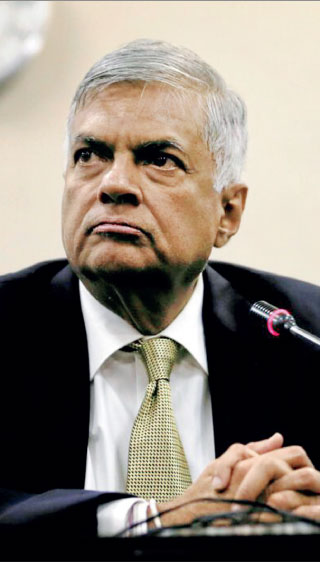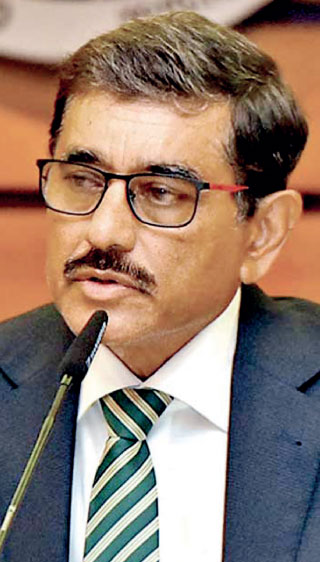Tuesday Dec 23, 2025
Tuesday Dec 23, 2025
Monday, 27 June 2022 00:43 - - {{hitsCtrl.values.hits}}

President Gotabaya Rajapaksa

PM Ranil Wickremesinghe

Central Bank Governor Dr. Nandalal Weerasinghe

Finance Ministry Secretary K.M. Mahinda Siriwardana
|
Aseni, whiz kid in economics, has been intrigued by three pieces of hot news that had hit the media last week. One was the arrival of the legal and financial advisors hired by the Government to initiate work on planned restructuring of some selected foreign debt contracted by the Government. The second was fielding of a staff-team by IMF to arrive at a staff-level agreement for a bailout package for Sri Lanka which in the opinion of the Prime Minister and Finance Minister, Ranil Wickremesinghe, is saddled with a collapsed economy.
Both news items were promising. But the third was somewhat negative because one of the investors in the International Sovereign Bonds maturing on 25 July 2022, Hamilton Reserve Bank, had taken the Government of Sri Lanka to New York Federal Court and pleaded for a direction that the Government should pay in full the principal plus interest due to them amounting to $ 257 million. She asked her grandpa, Sarath Mahatthaya, an ex-employee of the Ministry of Finance, about this.
The following is the conversation between Aseni and Sarath.
 Aseni: Grandpa, the Government had hired a legal consultant and a financial consultant to help it restructure selected foreign borrowings because it does not have forex to pay them, and it is one of the pre-conditions for seeking a bailout package from IMF. While this work is going on, one of the investors in the ISB due to mature on 25 July 2022, namely, Hamilton Reserve Bank, has filed a case against the Government in New York Federal Court demanding the full repayment of the moneys they have invested in those ISBs. What is this court case and how will it affect the Government’s planned debt restructuring program?
Aseni: Grandpa, the Government had hired a legal consultant and a financial consultant to help it restructure selected foreign borrowings because it does not have forex to pay them, and it is one of the pre-conditions for seeking a bailout package from IMF. While this work is going on, one of the investors in the ISB due to mature on 25 July 2022, namely, Hamilton Reserve Bank, has filed a case against the Government in New York Federal Court demanding the full repayment of the moneys they have invested in those ISBs. What is this court case and how will it affect the Government’s planned debt restructuring program?
Sarath: Hamilton Reserve Bank is not a US bank, but one that has its headquarters in St. Kitts and Nevis, a tiny British Commonwealth country in the Caribbean. It is a popular tax haven. They have sued Sri Lanka in USA because the law applicable to the issue of these ISBs is the US Law and not the Sri Lanka Law. Their action is like placing a spanner in the path of the Sri Lanka Government which is planning to go for a debt restructuring.
What has been planned by the Government is to restructure some selected borrowings, namely, from commercial markets by issuing ISBs, and from bilateral sources – they are called bilateral because only one lender and borrower are involved. Borrowings from individual countries like China, India, Japan, UK, USA, and so on are included in this latter category. In addition, the Government has borrowed from international financial institutions – called multilateral sources – like ADB, World Bank, International Fund for Agriculture Development, etc., and by issuing bonds denominated in US dollars called Sri Lanka Development Bonds or SLDBs. These two categories are not in the debt restructuring plan. But, since Sri Lanka does not have foreign exchange, the country is unable to repay such debt also. The bitter truth is that Sri Lanka will have to default all its foreign debt that includes borrowings by government corporations like CPC, SriLankan Airlines, Water Board, and so on, and those borrowed by the private sector businesses.
Under restructuring, both the borrower and the lender will agree to a new repayment plan. That should necessarily be repayment of less than the full amount. It can be waiving of the interest or waiving of some part of the principal or a combination of both. When interest or some part of the principal is waived, it is called in investment jargons taking a ‘haircut’. For instance, if 25% of the principal is waived, it is called a haircut of 25% which the lender should forego. Since the alternative is to lose everything, a haircut of less than 100% is a better deal. However, the size of the haircut will depend on the relative bargaining power of either party. That is because the borrower wants to give the largest haircut, while the lender wants to accept the smallest haircut. Since both parties hire competent legal and financial advisors to argue their case, the negotiation will be a tough job.
Sri Lanka’s bargaining power will be weakened by the new court case against it. If the New York Federal Court delivers its judgement in favour of Hamilton Reserve, Sri Lanka will have to make the full payment on 25 July. If it does so, the other creditors will also ask for the same treatment on the principle of equal treatment. Then, the debt restructuring plan will come to a standstill. If it does not pay, it will amount to a default and the country runs the risk of its assets within the jurisdiction of the court being confiscated to recover the debt. For instance, if a Sri Lankan plane lands in USA or elsewhere, the lender can invoke the court’s jurisdiction to acquire it to recover its debt. In a similar judgment delivered against Argentina, a frigate belonging to that nation and anchored in Ghana was detained to recover the dues to bondholders. That is because when sovereign bonds are issued, the issuing country forfeits its sovereign immunity rights.
These lenders who take the borrowers to courts are called ‘holdout investors’ because they stand outside the negotiating creditors putting a hold on the ongoing restructuring plan. And these litigations may take many years for conclusion. For instance, in the case of Argentina, the whole restructuring plan was made inactive by some bondholders taking the country to courts in USA and the US courts took some 10 years to deliver the judgement. Hence, this court case is necessarily a spanner placed in Sri Lanka’s path.
Aseni: I hear that debt restructuring is a precondition for Sri Lanka to get an IMF bailout. If so, does this mean that this bailout negotiations will be delayed?
Sarath: In a way yes. If the issue with the holdout bondholders can be resolved amicably and quickly, there is no impediment for the proposed bailout package. But that depends on the conditions of the bond issues. Prior to 2015, the typical sovereign bonds had a clause that had given extra powers to bondholders called Collective Action Clause or CAC. Under that clause, even a single bondholder can hold the borrower at ransom and demand preferential treatment. This CAC is not applicable to all the bonds issued as a pool but to each bond issued. They are called single series CACs.
But after 2015, there was a new innovative clause under which if 75% of the bondholders agree, they could go ahead with a debt restructuring plan even if the balance 25% disagrees. Hence, the bond maturing on 25 July 2022, issued prior to 2015, will be subject to this impediment. As such, the restructuring could get delayed if the New York Federal Court delivers its judgement against Sri Lanka. If it happens, it will also delay Sri Lanka’s planned bailout from IMF. That is why I said that it is advisable for Sri Lanka to resolve that issue amicably and quickly.
Aseni: You said that since Sri Lanka does not have forex, it is likely that it will default all the foreign currency denominated debt, both public and private. However, there are some experts who have argued that Sri Lanka’s foreign currency denominated debt has been underreported. Is it correct Grandpa?
Sarath: In public discussions, many refer to the total foreign currency debt as equal to $ 51 billion picking a number that has been published by the Central Bank in its Annual Report for 2021. This has grossly underreported the foreign currency borrowings of the country. This has been a practice adopted by the Central Bank since 2020. According to the Bank, this $ 51 billion is made up of $ 27 billion representing the central government and $ 24 billion owed by the non-government sector. This latter category is made up of borrowings by the Central Bank, commercial banks, savings and development banks, public corporations, and the private sector businesses.
To arrive at the true foreign currency borrowings of the country, we will have to make a reconciliation of the numbers published by the Bank. Let’s start with the central government debt which has been recorded as $ 27 billion. This is mostly made up of loans obtained by the government amounting to $ 21 billion and bonds amounting to $ 6 billion. The loans have been recorded at their face value liability. But several adjustments have been made to the value of bonds which do not stand to economic logic. In the case of international sovereign bonds or ISBs, the face value liability has been $ 13 billion.
But the Central Bank has changed this value by making two adjustments. One is that the ISBs held by local commercial banks and individuals have been removed from this value and recorded it as a domestic borrowing of the Government. The second is of the remaining ISB value, what has been taken to books is their market price and not the amount which the Government should pay at the end. Since ISBs are traded at a deep discount today – for instance, an ISB with a repayment liability of $ 100 is traded on average at around $ 40 – the value so recorded is less by $ 60 than its true level.
In addition, the amount of Sri Lanka Development Bonds or SLDBs held by local commercial banks and individuals have been removed from the foreign debt and added to Government’s domestic debt. In this manner, the total underreporting of government’s foreign debt has been $ 9 billion. This will make the central government’s borrowing $ 36 billion and the total country borrowing $ 60 billion.
The story does not end there. There are public corporations like CPC, CEB, Water Board, etc. which have raised foreign funds on guarantees given by the Government. Since these institutions cannot repay these loans, ultimately, the Government will be required to shoulder the burden. This category has an outstanding balance of $ 9 billion. Accordingly, the central government’s borrowings will increase to $ 45 billion and the total country borrowings to $ 69 billion or 82% of GDP. This is the total value of foreign currency borrowings which the Government must repay.
Aseni: You said that this adjustment does not stand to economic logic. Why is it so?
Sarath: In the case of a creditor, when the market price goes down, he should make a ‘mark to market’ adjustment by reducing his lending portfolio to the market price. But the amount written off is a loss and should be charged to the profit and loss account. A debtor cannot do this, unless creditors have agreed to write it off. In Sri Lanka’s case this has not happened. Further, if such a write-off is allowed, the amount written off is a gain for Sri Lanka and it should be written back to the revenue of the budget. The Central Bank has not done this adjustment. Hence, it is an arbitrary writing-off.
Categorising the dollar denominated bonds held by domestic entities as domestic debt is meaningless because they are to be repaid in dollars and not in rupees. In fact, when they matured, the full amount was paid in dollars. Hence, the adjustment made by the Central Bank does not stand to economic logic. It seems that the Bank has confused debtors with creditors.
Aseni: What this means is that the Government should have a restructuring plan for the entire value of $ 45 billion. In addition, those private sector borrowings amounting to $ 24 billion may also need a similar restructuring process. What is your view on this, Grandpa?
Sarath: True, the Government cannot do this restructuring in piecemeal. If it pays the full value for some creditors and ask others to agree to a haircut, they might ask Sri Lanka to apply the principle of equal treatment. It also weakens Sri Lanka’s defence in the New York Federal Court.
About the private sector debt, since Sri Lanka does not have foreign exchange reserves to service it, there is a likelihood of forced default of that debt. This problem does not arise if the private sector entities can repay those loans by borrowing again from that source or from elsewhere. But with lower credit rating for sovereign Sri Lanka at ‘restrictive default’ or RD level, it is very unlikely to happen. This is because when the sovereign rating is at a certain level, the entities in the country cannot get a rating above that level. For instance, Fitch Ratings has downgraded the short-term and long-term foreign borrowings of the Bank of Ceylon to RD from C level quoting that the Bank has missed one of its recent debt repayments. Hence, the next debt crisis will hit the country when the private entities are unable to raise foreign funds anymore.
Sri Lanka’s Central Bank is facing this problem right now. If it cannot get the SWAP facilities with other central banks extended when they mature, it will have to default them because it has no capacity to repay them with its negative foreign reserves at $ 4 billion as at the end of April 2022. This is why it is important for Sri Lanka to get this IMF bailout package as soon as possible.
Aseni: What about the domestic borrowings of the Government? Are those loans too facing a similar problem?
Sarath: The advantage of domestic borrowings of the Government is that they can be repaid by printing money if the market participants do not want to lend to the Government at the going interest rates. This happened in the case of the previous week’s Treasury bill issue. The Central Bank had offered Rs. 93 billion to the market, but it could get from the market at the prevailing bill rates of around 21% only Rs. 31 billion. The Central Bank had to give a major part of the balance Rs. 62 billion to the Government by issuing a Treasury bill to itself. The ordinary people call this money printing. As a result, the Central Bank’s Treasury bill holdings have increased to Rs. 2,086 billion on Friday, 24 June from Rs. 2,043 billion a day ago.
But this money printing is not a healthy feature for inflation fighting, exchange rate stabilisation, and overall macroeconomic stability of the country. It will also hamper Sri Lanka’s ongoing negotiations with IMF for a bailout package. That is because one of the preconditions for the bailout package is to cease the central bank funding of the government. For that purpose, IMF has recommended to the Government to get funding by adjusting the tax rates which Ministry of Finance has done only halfway through.
In this context, Aseni, someone can argue that Sri Lanka’s domestic debt is not sustainable. Hence, it is not a surprise if the demand for restructuring of the domestic debt is also presented as a precondition for this IMF bailout.
Aseni: Thanks, Grandpa, for the explanation. I have now learned the complexity of these debt restructuring exercises. It is not a cakewalk but a task which should be carefully planned and implemented.
(The writer, a former Deputy Governor of the Central Bank of Sri Lanka, can be reached at [email protected].)